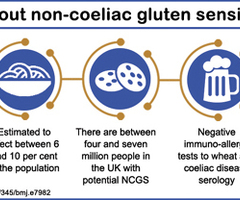Celiac disease, non-celiac gluten sensitivity or wheat allergy: what is the difference?

Tags: Internal Medicine, Family Medicine
Celiac disease (CD), non-celiac gluten sensitivity (NCGS) and wheat allergy are all conditions whose primary treatment is avoidance of specific dietary components. Celiac disease and non-celiac gluten sensitivity have many symptoms in common, whereas those of wheat allergy are usually distinct. Possible symptoms of CD and NCGS include gastrointestinal symptoms such as cramping, diarrhea and constipation, as well as symptoms in other parts of the body such as bone or joint pain, headaches, or fatigue, to name a few. Symptoms of an allergy to wheat can include itching, hives, or anaphylaxis, a life-threatening reaction. Treatment for CD and NCGS is to remove gluten from the diet. Gluten is a protein naturally found in wheat, rye and barley, as well as in hybrids and products made from these grains. Treatment for wheat allergy is removal of all forms of wheat from the diet. People with CD, NCGS, or wheat allergy are fortunate because they don’t need complicated medical treatments to get well, but they must avoid the food or foods that are problematic. Let’s take a closer look at each of these types of reactions to food.

Figure 1. Establishing non-celiac gluten sensitivy symptoms through comparison with IBS and true celiac disease.
Celiac disease (CD) is a genetic, autoimmune disorder that occurs in reaction to the ingestion of gluten. To develop celiac disease a person must inherit the genetic predisposition, be consuming gluten, and have the disease activated. Activation triggers may include stress, trauma (surgeries, etc.) and possibly viral infections. The reaction to gluten causes villous atrophy or flattening of the cells lining the small intestine, which can lead to malabsorption of nutrients and related health issues. There are over 200 identified symptoms of CD, which include those listed above as well as anemia, behavioral changes, stunted growth and infertility. Dermatitis herpetiformis is celiac disease that manifests as a skin rash. The rate of CD is higher among relatives of those who are diagnosed, but anyone with the genetic predisposition can develop celiac disease at any age. Currently it is estimated that about 1% of the population has celiac disease, although 83% of those people are still undiagnosed. While research continues to work towards pharmaceutical or other treatments, at this time the only treatment for celiac disease is to maintain a gluten-free diet for life.

Figure 2. Five facts about non-celiac gluten sensitivity
Non-Celiac Gluten Sensitivity (NCGS), also referred to as gluten sensitivity (GS) or non-celiac wheat sensitivity (NCWS), is not well defined. It is not an immunoglobulin E (IgE) (as with wheat allergy, see below) nor autoimmune reaction (as with CD, see above). NCGS may have an innate immune component, but this has not been firmly established. There are no tests or biomarkers to identify NCGS. Since NCGS is not well understood it is still not clear whether other components of gluten-containing grains may be involved in causing symptoms, at least in some cases. In order for gluten sensitivity to be diagnosed, it is first necessary to rule out CD, wheat allergy or other possible causes of symptoms. Then, if improvement is seen when following a gluten-free diet, gluten sensitivity may be diagnosed. Adherence to a gluten-free diet is the only treatment for NCGS at this time.
Wheat allergy is an immune reaction to any of the hundreds of proteins in wheat. When a person has a wheat allergy, one type of white blood cells, called B-cells, send out immunoglobulin E (IgE) antibodies to “attack” the wheat. At the same time, local tissues in the body send out natural chemical messengers to alert the rest of the body that there is a problem. This reaction happens very fast (within minutes to a few hours) and can involve a range of symptoms from nausea, abdominal pain, itching, swelling of the lips and tongue, to trouble breathing, or anaphylaxis (a life-threatening reaction). A person with a wheat allergy must avoid eating any form of wheat, but does not have trouble tolerating gluten from non-wheat sources. (It is possible for a person to be both allergic to wheat and have CD or NCGS.) In the United States, wheat is one of the eight most common foods to which people are allergic. Children who are allergic to wheat may out-grow the allergy, but adults with an allergy to wheat usually have it for life. The only treatment is a wheat-free diet.
References
Comments





Attached Media
 Sign in with facebook
Sign in with facebook
 Sign in with google
Sign in with google

